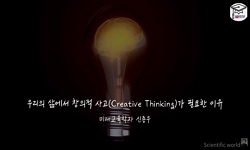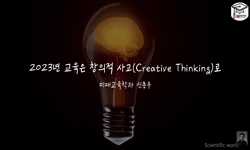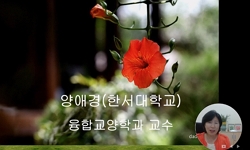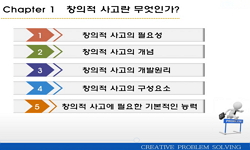The purpose of this study is to examine the differences between creative thinking and creative personality of university students according to their associative hierarchy, and explore the possibility of using RAT(Remote Associate Test) as an alternati...
http://chineseinput.net/에서 pinyin(병음)방식으로 중국어를 변환할 수 있습니다.
변환된 중국어를 복사하여 사용하시면 됩니다.
- 中文 을 입력하시려면 zhongwen을 입력하시고 space를누르시면됩니다.
- 北京 을 입력하시려면 beijing을 입력하시고 space를 누르시면 됩니다.
https://www.riss.kr/link?id=A103534724
- 저자
- 발행기관
- 학술지명
- 권호사항
-
발행연도
2017
-
작성언어
-
- 주제어
-
KDC
370
-
등재정보
KCI등재
-
자료형태
학술저널
- 발행기관 URL
-
수록면
1-19(19쪽)
-
KCI 피인용횟수
4
- 제공처
-
0
상세조회 -
0
다운로드
부가정보
다국어 초록 (Multilingual Abstract)
The purpose of this study is to examine the differences between creative thinking and creative personality of university students according to their associative hierarchy, and explore the possibility of using RAT(Remote Associate Test) as an alternative creativity test. To carry out this study, 174 university students at one university in Chungnam Province, took TTCT(Torrence Test of Creative Thinking), RAT, and a creative personality test. The 115 respondents who responded to the survey carefully were chosen as the final subjects. The results of this study are as follows. First, there was a significant difference in the whole creativity and subordinate factors of creative thinking, flexibility, and originality, of university students. The creative thinking of the flat associative hierarchy group was significantly higher than that of the steep group. Second, there was no significant difference in the creative personality of the university students except imagination between the types of associative hierarchies. This study suggests that university students in a group of flat hierarchy have higher creative thinking skills and there is still the need for further study to use RAT as an alternative creativity test.
참고문헌 (Reference)
1 신진향, "한국어 원격연상단어검사(RAT)의 동형검사 신뢰도와 지시효과" 서울대학교 대학원 2014
2 한윤영, "통찰문제의 재구조화를 활용한 문제발견 검사로서의 K-RAT(Korean-Restructuring Test) 개발 및 타당화" 한국교육심리학회 26 (26): 1023-1051, 2012
3 김영채, "토란스 TTCT: 언어 A. B" 창의력 한국 FPSP 2004
4 표두미, "초·중·고등학교 학생들의 창의력과 성격 간 상관 연구: 창의력 올림피아드 참가 학생을 중심으로" 한국산학기술학회 16 (16): 7677-7689, 2015
5 이신동, "창의성의 이해" 박학사 2009
6 Weisberg, R. W., "창의성: 문제해결, 과학, 발명, 예술에서의 혁신" 시그마프레스 2009
7 김춘일, "창의성 추구를 위한 교육 : 교육과정과 관련한 하나의 기본 시각과 접근 방향" 18 (18): 63-88, 2000
8 배윤경, "창의성 및 지능과 학업 성취간의 상관" 梨花女子大學校 敎育大學院 1999
9 이신동, "지능과 창의성의 프레임" 양서원 2015
1 신진향, "한국어 원격연상단어검사(RAT)의 동형검사 신뢰도와 지시효과" 서울대학교 대학원 2014
2 한윤영, "통찰문제의 재구조화를 활용한 문제발견 검사로서의 K-RAT(Korean-Restructuring Test) 개발 및 타당화" 한국교육심리학회 26 (26): 1023-1051, 2012
3 김영채, "토란스 TTCT: 언어 A. B" 창의력 한국 FPSP 2004
4 표두미, "초·중·고등학교 학생들의 창의력과 성격 간 상관 연구: 창의력 올림피아드 참가 학생을 중심으로" 한국산학기술학회 16 (16): 7677-7689, 2015
5 이신동, "창의성의 이해" 박학사 2009
6 Weisberg, R. W., "창의성: 문제해결, 과학, 발명, 예술에서의 혁신" 시그마프레스 2009
7 김춘일, "창의성 추구를 위한 교육 : 교육과정과 관련한 하나의 기본 시각과 접근 방향" 18 (18): 63-88, 2000
8 배윤경, "창의성 및 지능과 학업 성취간의 상관" 梨花女子大學校 敎育大學院 1999
9 이신동, "지능과 창의성의 프레임" 양서원 2015
10 김기명, "지능과 창의성 수준에 따른 학업 성취 및 성격 특성 비교" 순천향대학교 교육대학원 2006
11 전경원, "종합창의성 모델의 5가지 창의성 영역" 5 : 23-29, 2001
12 송인섭, "자아개념의 다원성과 사회성취도의 관계" 5 (5): 3-17, 2001
13 이은혜, "원격 연상 검사의 구성 요소와 난이도 간의 관계" 서강대학교 일반대학원 2015
14 최형심, "어머니 및 교사가 인식한 유아의 창의적 성향과 유아의 창의적 사고와의 관계" 경희대학교 대학원 2005
15 최인수, "아동의 창의성과 성격 및 지능간의 관계: 창의성검사, Holland검사, Raven검사를 중심으로" 한국교육심리학회 19 (19): 135-158, 2005
16 한윤영, "문항반응이론을 적용한 한국형 재구조화연합검사(K-RAT)의 문항탐색" 한국영재교육학회 12 (12): 93-113, 2013
17 이신동, "대학생의 창의적 성격 비교" 한국교육방법학회 15 (15): 105-120, 2003
18 김기모, "대학생의 연상위계유형에 따른 창의적 사고와 창의적 성격비교" 순천향대학교 일반대학원 2017
19 이신동, "대학생용 창의적 성격검사의 개발 및 타당화 연구" 한국교육심리학회 16 (16): 43-61, 2002
20 Hamilton, M. A., "“JAMAICANIZING” the MEDNICK Remote Associates Test of Creativity" 55 (55): 321-322, 1982
21 Maduudx, W. W., "When in Rome, learn why the Romans do what they do : How multicultural learning experiences facilitate creativity" 36 : 731-741, 2010
22 Torrance, E. P., "Torrance tests of creative thinking: Directions manual and scoring guide (Verbal test booklet A, B)"
23 Lubart, T. I., "Thinking and problem solving" Cambridge University Press 1994
24 Guilford, J. P., "The structure of intellect" 53 : 267-293, 1956
25 Gupta, N., "The road not taken : Creative solutions require avoidance of high-frequency responses" 23 : 288-294, 2012
26 Mednick, S. A., "The associative basis of the creative process" 69 : 220-232, 1962
27 Mednick, S. A., "The Remote Associates Test" 2 (2): 213-214, 1968
28 Benedek, M., "Revising Mednick’s Model on creativity-related differences in associative hierarchies" 47 (47): 273-289, 2012
29 Amabile, T. M., "Perspective on the social psychology of creativity" 46 : 3-15, 2012
30 Smith, K. A., "Multiply-constrained semantic search in the remote associates test" 128 : 64-75, 2013
31 Runco, M. A., "Judgments of the creativity of artwork from students and professional artists" 128 (128): 23-31, 1994
32 Guilford, J. P., "Intelligence, creativity, and their educational implications" R. O. Knapp 1970
33 Amabile, T. M., "Growing up creative-nurturing a lifetime of creative" CEF Press 1989
34 Treffinger, D. J., "Fostering independence and creativity" 3 (3): 214-224, 1980
35 Sawyer, R. K., "Explaining creativity: The science of human innovation" Oxford University Press 2006
36 Mednick, S. A., "Examiner's manual, remote associates test : . College and adult forms 1 and 2" Houghton Mifflin 1967
37 Chermahini A. S., "Development and validity of a Dutch version of the Remote Associates Task: An item-response theory approach" 7 : 177-186, 2012
38 Pluker, J. A., "Creativity: from potential to realization" American Psychological Association 2004
39 Barron, F., "Creativity, intelligence and personality" 32 (32): 439-476, 1981
40 Torrance, E. P., "Creativity and learning" Houhton Mifflin 1967
41 Guilford, J. P., "Creativity" 5 (5): 444-454, 1950
42 Coney J., "Creative thinking from an information processing perspective : A new approach to Mednick's theory of associative hierarchies" 29 : 109-131, 1995
43 Karlins, M., "Conceptual complexity and remote-associative proficiency as creativity variables in a complex problem solving task" 6 : 264-278, 1967
44 Cunningham, J. B., "Categories of insight and their correlates : An exploration of relationships among classic-type insight problems, revers puzzles, remote associates and esoteric analogies" 43 : 1-22, 2009
45 Torrance, E. P., "Can we teach children to think creatively?" 6 (6): 114-143, 1972
46 Kaufman, J. C., "Beyond big and little : The four models of creativity" 13 (13): 1-12, 2009
47 Friedman, R. S., "Attentional priming effects on creativity" 15 : 277-286, 2003
48 Benedek, M., "Associative abilities underlying creativity" 6 : 273-281, 2012
49 Pluker, J. A., "Assessment of creativity"
50 Ochse, R., "A critical appraisal of the theoretical validity of the Mednick Remote Associations Test" 20 (20): 195-199, 1990
동일학술지(권/호) 다른 논문
-
- 한국홀리스틱융합교육학회
- 김수동(Kim Soo Dong)
- 2017
- KCI등재
-
- 한국홀리스틱융합교육학회
- 김지연(Kim Ji Yeon)
- 2017
- KCI등재
-
통합적 관점에서 본 초등 교사의 스포츠교육모형에 대한 이해와 오해
- 한국홀리스틱융합교육학회
- 임명재(Lim Myoung Jae)
- 2017
- KCI등재
-
홀리스틱 교육의 관점에서 본 학교평가 결과와 관련된 평가지표 탐색
- 한국홀리스틱융합교육학회
- 정규열(Chung Kyu Yeul)
- 2017
- KCI등재
분석정보
인용정보 인용지수 설명보기
학술지 이력
| 연월일 | 이력구분 | 이력상세 | 등재구분 |
|---|---|---|---|
| 2022 | 평가예정 | 재인증평가 신청대상 (재인증) | |
| 2019-01-01 | 평가 | 등재학술지 유지 (계속평가) |  |
| 2017-02-02 | 학회명변경 | 한글명 : 한국홀리스틱교육학회 -> 한국홀리스틱융합교육학회영문명 : Korean Society for Holistic Education -> The Korean Society for Holistic Convergence Education |  |
| 2017-02-02 | 학술지명변경 | 한글명 : 홀리스틱교육연구 -> 홀리스틱융합교육연구외국어명 : Journal of Holistic Education -> Journal of Holistic Convergence Education |  |
| 2016-01-01 | 평가 | 등재학술지 선정 (계속평가) |  |
| 2015-01-01 | 평가 | 등재후보학술지 유지 (계속평가) |  |
| 2013-01-01 | 평가 | 등재후보 1차 PASS (등재후보1차) |  |
| 2012-01-01 | 평가 | 등재후보학술지 유지 (기타) |  |
| 2011-01-01 | 평가 | 등재후보 1차 PASS (등재후보1차) |  |
| 2010-01-01 | 평가 | 등재후보 1차 FAIL (등재후보2차) |  |
| 2009-01-01 | 평가 | 등재후보 1차 PASS (등재후보1차) |  |
| 2007-06-26 | 학회명변경 | 영문명 : Korean Society For Holistic Education -> Korean Society for Holistic Education |  |
| 2007-06-20 | 학회명변경 | 영문명 : The Korean Society For Holistic Education -> Korean Society For Holistic Education |  |
| 2007-06-19 | 학회명변경 | 한글명 : 한국홀리스틱교육실천학회 -> 한국홀리스틱교육학회영문명 : The Korean Society For Practical Research In Holistic Education -> The Korean Society For Holistic Education |  |
| 2007-01-01 | 평가 | 등재후보학술지 선정 (신규평가) |  |
학술지 인용정보
| 기준연도 | WOS-KCI 통합IF(2년) | KCIF(2년) | KCIF(3년) |
|---|---|---|---|
| 2016 | 1.12 | 1.12 | 1.13 |
| KCIF(4년) | KCIF(5년) | 중심성지수(3년) | 즉시성지수 |
| 1.16 | 1.21 | 1.342 | 0.14 |




 KCI
KCI 스콜라
스콜라






